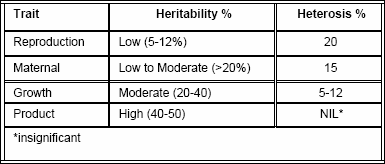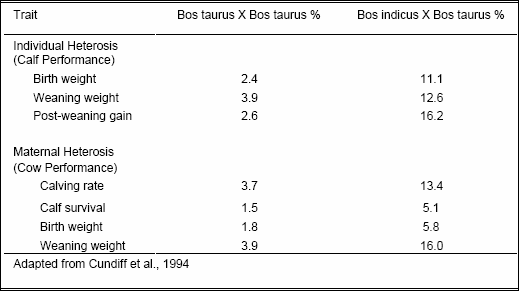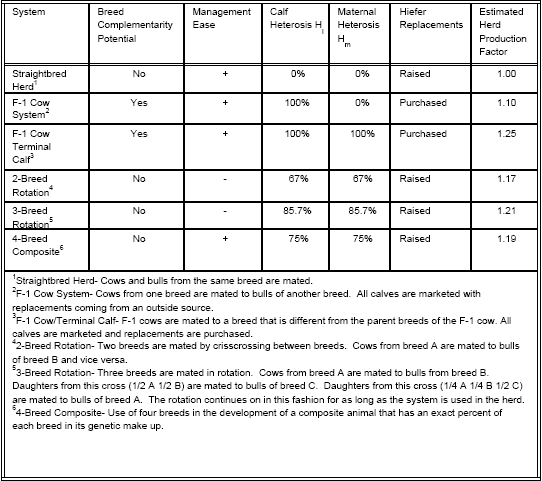



Crossbreeding Systems in Beef Cattle
By Gary R. Hansen and published by University of Florida IFAS Extension - As selection for carcass quality has taken center stage in the beef cattle industry, cattle producers have adopted strategies that have decreased the use of crossbreeding in beef cattle herds.Crossbreeding leads to increased performance without any added costs or inputs. It is one of the few management tools that increase productivity and improve the line when properly used. Despite the benefits of the practice, however, cattle producers have adopted strategies that have decreased the use of crossbreeding in beef cattle herds because selection for carcass quality has primary importance in the beef cattle industry.
Crossbreeding works as a result of heterosis, also known as hybrid vigor. Hybrid vigor is the amount by which crossbred animals exceed (or differ from) the average of the purebred parents used in the cross (expressed in units or percent). This idea can best be illustrated through the example listed below for weaning weight.
- Brahman average 500 lbs
- Angus average 550 lbs
- Average of purebreds 525 lbs
- Average of crossbred progeny 575 lbs -
- (1/2 Brahman 1/2 Angus)
- Hybrid vigor = 575- 525 = 50 lbs difference
- Percent hybrid vigor 50/525 = 9.52%
Hybrid vigor is expressed in almost all beef cattle production traits, especially in reproduction and adaptability traits. Table 1 explains the relationship between heritability and heterosis regarding different categories of beef cattle traits. Since reproduction and maternal traits have low heritability, response to selection will be slow. At the same time, significant improvement in these traits can be made through programs that maximize heterosis.
economic importance in beef cattle production

The inverse is true with product or carcass traits. Significant and rapid progress can be made through selection for carcass traits, while crossbreeding has little or no effect. Growth traits are moderate for both heritability and heterosis, making progress possible through selection and crossbreeding.
Using this information, commercial producers can tailor a program to fit their individual needs. If a producer is concerned about carcass characteristics, then selection is the best way to improve quality. On the other hand, if reproductive rates need to be enhanced, crossbreeding is the quickest and easiestway to improve. It should be realized that no one breed is best at everything.
Producers should use breeds that complement each other. For example, breeds that have low marbling would need to be mated to animals with high marbling potential. Continental animals and British animals are good examples of breeds that complement each other. It also should be noted that breeds from diverse genetic backgrounds will express higher levels of hybrid vigor when crossed. For example, British breeds crossed with each other will result in hybrid vigor, but at lower levels than British breeds crossed with Continental or Bos indicus (Zebu) breeds (Table 2).
traits when crossing divergent breed types of cattle.

It should be stressed that there needs to be a planned program if expected results are to occur. In the past, producers have thought of crossbreeding as simply replacing bulls every 2 to 3 years with whatever breed was popular at the time. This has lead to problems with uniformity of the resulting product. Quality cattle need to be selected in order for crossbred cattle to out-perform straightbred cattle and produce the type of product that is in demand by the consumer. Crossbreeding will not overcome poor genetics.
Crossbreeding can be a very effective tool to improve reproductive and weaning rates in beef cattle. Table 3 shows the results of Charolais bulls naturally mated to various types of purebred and crossbred cows. All cows were managed in a single herd and data was collected over a three-year period. Cows were located in central Texas. Weaning weights were adjusted to 205 days as well as for age of dam. Records from first-calf heifers were excluded.

Weaning weight per cow exposed to breeding is the best figure to sum up production efficiency. The calculation includes reproduction and gestation efficiency, calving management and survival from birth to weaning. Using the above data, the difference in the Hereford versus the Brahman X Hereford cows was 211 pounds of extra weaning weight per cow exposed. This points out the advantage of using crossbred cows, especially Bos indicus (Bi) X Bos taurus (Bt) breed types. Olson et al., 1991, compared different crossbred cattle in Nebraska and Florida.
The study showed that Bos indicus X Bos taurus cows weaned calves approximately equal in weaning weight per cow exposed in Florida and Nebraska, but weaned 62 and 34 more pounds in comparison than Bos taurus X Bos taurus cows in Florida and Nebraska, respectively. The Zebu productivity advantage in Florida was up to three times greater than that experienced in Nebraska.
Using various systems of crossbreeding can have a significant impact. The various systems of crossbreeding yield different results in a beef cattle operation. Table 4 summarizes some of the more popular crossbreeding programs available for commercial producers to use. The estimated herd production factor uses the straightbred herd as the baseline. Each system should be carefully analyzed before implementing the program in a commercial operation. Some systems will not work for small producers. Others require a stable source from which quality replacement females can be purchased. Each system has advantages and disadvantages. However, cattle producers should find a way to capture hybrid vigor in their herd.

Estimated herd production factor is the increase in production that would be realized in each crossbreeding system. Notice that the F-1 Cow/Terminal calf system results in the highest percent of heterosis expressed in a crossbreeding system with a factor of 1.25 while the straightbred herd is 1.00. This simply means that using the F-1 Cow/ Terminal calf system will result in a 25% increase in production. However, the other factors should be considered before determining which crossbreeding system to use.
In summary
- Breeds from diverse environments (genetic backgrounds) express more total heterosis in the maternal and individual.
- Breeds should be matched to complement each other. Use animals that will work in your environment and management system.
- Source of replacements must be considered in order to insure that the crossbreeding program will work.
- Heterosis cannot overcome a poor quality genetic base. Use quality animals when selecting bulls to use in your herd.
- Use breeds that will be the most economically productive for your operation and management style.
- Commit to a crossbreeding system and stick to it. Do not become the bull of the month club with your bull battery.
Reference
Olson, T.A., K. Euclides Filho, L. V. Cundiff, M. Koger, W.T. Butts, Jr, and K.E. Gregory. 1991 Effects of breed group by location interaction on crossbred cattle in Nebraska and Florida. J. Anim. Sci 69:104-114



